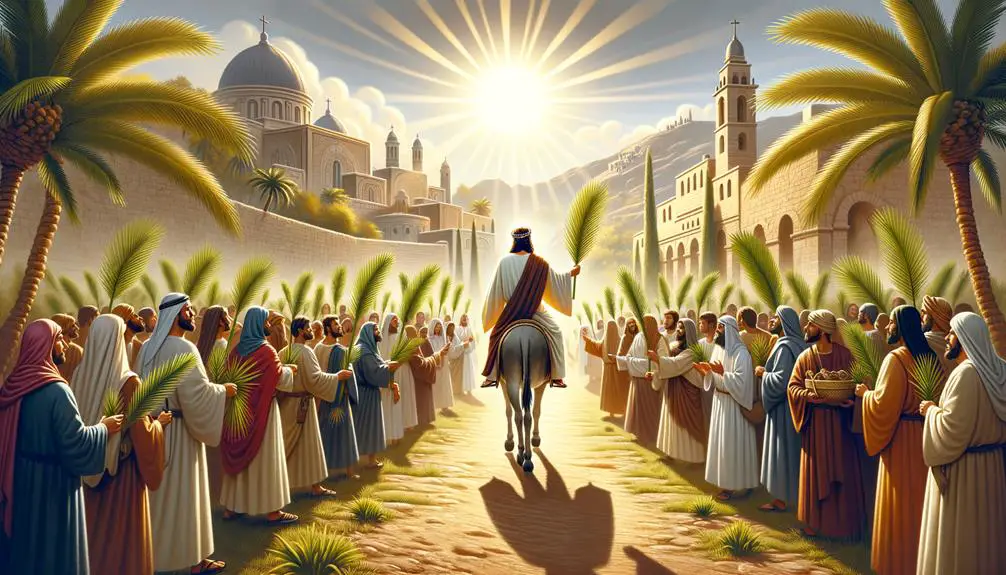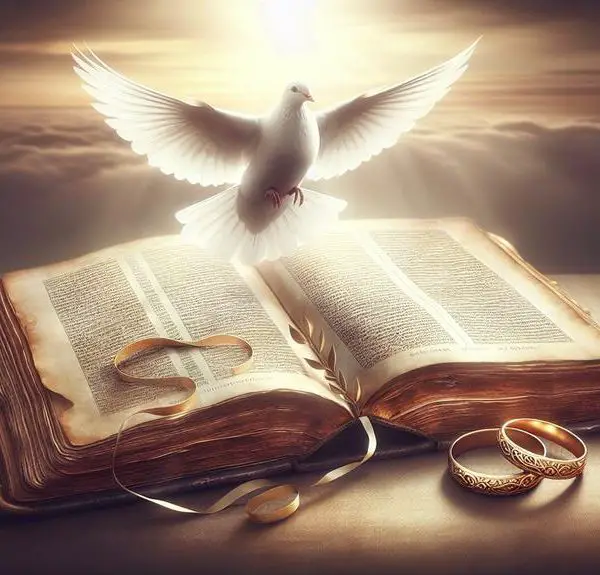Unlock the secrets of Palm Sunday in the Bible's Gospels, where triumph and prophecy intertwine, beckoning a deeper exploration.

Where in the Bible Does It Talk About Palm Sunday
Just as travelers in ancient times laid down palm branches to welcome a victorious king, you'll find the Bible's accounts of Palm Sunday ushering in the final week of Jesus' earthly ministry with a similar sense of celebration and significance.
You'll discover this narrative spread across the Gospels of Matthew, Mark, Luke, and John, each offering a unique lens on the event that marked the beginning of the end of Jesus' journey on earth.
But what sets each account apart, and how do these differences enrich our understanding of Palm Sunday's place in Christian tradition? Uncover the layers, and you'll find there's more to this story than meets the eye.
Key Takeaways
- Palm Sunday is documented in all four Gospels: Matthew, Mark, Luke, and John.
- Each Gospel presents unique aspects of Jesus' entry into Jerusalem, highlighting its significance.
- Symbolism such as palm branches and a donkey play crucial roles in the narratives.
- The event marks the beginning of Holy Week, leading to Jesus' crucifixion and resurrection.
Overview of Palm Sunday

Marking the beginning of Holy Week, Palm Sunday commemorates Jesus Christ's triumphant entry into Jerusalem, an event richly documented in all four canonical Gospels. This day holds profound historical context and cultural implications that merit your close examination.
In the broader historical context, Palm Sunday didn't simply mark an event; it was a fulcrum around which the final week of Jesus's earthly ministry pivoted. The act of laying palm branches, a symbol of victory and peace in ancient times, before Jesus as he entered Jerusalem, was deeply symbolic, representing the acknowledgment of Jesus as the prophesied king. This moment, as narrated, wasn't just a spontaneous act of adoration but a deeply political gesture that challenged the existing power structures of the time.
The cultural implications of Palm Sunday are equally significant. In a period marked by Roman occupation and political unrest, Jesus's entry into Jerusalem on a donkey, a symbol of peace rather than war, presented a stark contrast to the expectations of a Messiah who'd overthrow Roman rule through military might. This event set the stage for the unfolding of a narrative that challenged not only the political and religious authorities of the day but also the very notion of kingship and power.
Analyzing Palm Sunday through these lenses, you're invited to appreciate not just the biblical narrative but the complex interplay of history, politics, and prophecy that it encapsulates. This day wasn't merely a moment in time but a pivotal event that would forever alter the course of history, embodying the tensions between earthly kingdoms and the kingdom of God.
Gospel of Matthew's Account
You'll find the Gospel of Matthew uniquely positions the triumphal entry of Jesus into Jerusalem, emphasizing specific elements that distinguish its narrative.
In Matthew 21:1-11, the account meticulously details the fulfillment of prophecy and the crowd's dynamic reaction, underscoring the messianic expectations of the period.
This analysis invites you to consider the theological and historical implications of these descriptions, shedding light on their significance in the broader context of Palm Sunday.
Triumphal Entry Described
How does the Gospel of Matthew depict the Triumphal Entry, and what unique insights does it offer into this pivotal moment? Matthew's account emphasizes the fulfillment of prophecy and the symbolism of the donkey, presenting Jesus' entry into Jerusalem as a moment of divine orchestration.
Aspect |
Description |
|---|---|
Donkey Symbolism |
Represents peace and humility, contrasting royal entries on horses. |
Prophecy Fulfillment |
Echoes Zechariah 9:9, underscoring Jesus' messianic identity. |
Divine Orchestration |
Actions and preparations are led by divine instructions. |
Entry into Jerusalem |
Marks a pivotal moment in Jesus' ministry and the Passion Week. |
Analyzing Matthew's narrative, you'll see a meticulously crafted account where every detail, from the donkey's selection to the route taken, serves to underscore Jesus' role as the prophesied Messiah, entering Jerusalem not as a worldly king, but as the prince of peace.
Crowd's Reaction Highlighted
Building on the meticulously crafted depiction of Jesus' entry into Jerusalem, Matthew's Gospel further enriches this pivotal moment by vividly portraying the crowd's dynamic reaction. This detailed account not only adds emotional depth but also provides valuable insights into the historical context and the cultural implications of this event.
- The crowd's spontaneous outpouring of praise reflects the messianic expectations of the time.
- Their use of palm branches symbolizes victory and triumph, deeply rooted in Jewish tradition.
- Shouts of 'Hosanna' underscore a plea for salvation, highlighting the communal hope for liberation.
- The diverse composition of the crowd mirrors the societal anticipation.
- Matthew's emphasis on the city's stirred reaction underscores the significant impact of Jesus' arrival.
This analytical approach reveals the complex interplay of emotions and expectations surrounding Palm Sunday.
Mark's Narrative on Palm Sunday

In Mark's Gospel, the narrative of Palm Sunday unfolds with Jesus's triumphant entry into Jerusalem, marking a pivotal moment in Christian tradition and biblical scholarship. This event isn't only a significant historical occurrence but also a rich tapestry of Mark's symbolism and prophetic fulfillment, offering a profound insight into the theological underpinnings of the Gospel.
Mark's account, detailed in chapter 11 verses 1-11, portrays Jesus instructing his disciples to fetch a colt, an act that directly fulfills the prophecy found in Zechariah 9:9. This moment is emblematic of Jesus's kingship, yet it diverges from conventional regal imagery, highlighting a kingdom based on peace rather than warfare. Mark's symbolism here is multifaceted, emphasizing both the fulfillment of Old Testament prophecies and the inauguration of a new, humble form of leadership.
Furthermore, the act of spreading cloaks and branches on the road before Jesus as he enters Jerusalem is laden with significance. This gesture, rooted in Jewish tradition, was a sign of royal respect and honor, yet, in the context of Mark's narrative, it also symbolizes the recognition of Jesus's radical redefinition of kingship. The crowd's acclamation, 'Hosanna! Blessed is he who comes in the name of the Lord!' encapsulates the dual nature of Jesus's mission: a messianic deliverance deeply intertwined with suffering.
In analyzing Mark's narrative of Palm Sunday, one observes a meticulously crafted account that intertwines historical event, prophetic fulfillment, and theological symbolism. This multi-layered narrative invites readers to ponder the paradox of a triumphant yet humble messiah, setting the stage for the events of Holy Week that follow.
Luke's Description of the Event
Turning our attention to Luke's Gospel, we observe a distinct portrayal of Palm Sunday that adds unique dimensions to our understanding of this pivotal event. In Luke 19:28-40, the narrative unfolds with Jesus' entry into Jerusalem, an event that's symbolically rich and layered with meaning, particularly through the use of olive branches and donkey symbolism.
- Olive branches, traditionally symbols of peace, underscore Jesus' mission as the bringer of peace between God and humanity. Their presence in the narrative evokes a deep sense of hope and reconciliation.
- The choice of a donkey, as opposed to a horse, symbolizes humility and peace, contrasting the expectations of a militaristic messiah with Jesus' actual peaceful purpose.
- Luke's emphasis on the donkey, which had never been ridden, highlights the sanctity and uniqueness of Jesus' kingship.
- The spontaneous chorus of praise from the crowd, “Blessed is the king who comes in the name of the Lord!” (Luke 19:38), stirs a profound emotional response, reflecting the people's longing for salvation.
- Luke's careful detailing of the preparations for Jesus' entry, including the disciples fetching the donkey, underlines the divine orchestration behind the scenes, inspiring awe and reverence.
Luke's narrative, while scholarly in its approach, deeply engages the reader by weaving together elements of prophecy, symbolism, and emotion. The inclusion of olive branches and the nuanced portrayal of donkey symbolism not only enrich the historical and theological understanding of Palm Sunday but also invite readers to reflect on the deeper meanings of peace, humility, and divine purpose.
John's Perspective on Palm Sunday

John's Gospel offers a distinctive viewpoint on Palm Sunday, emphasizing the fulfillment of prophecy and the recognition of Jesus as the Messiah by the crowd. Compared to other accounts, John's emphasis on symbolic actions is more pronounced, illustrating a deeper theological significance behind the events.
For instance, when you examine John 12:12-15, you'll find a clear reference to Zechariah's prophecy, showcasing how Jesus' entry into Jerusalem on a donkey was a fulfillment of ancient predictions about the coming Messiah. This moment is pivotal, as it symbolizes Jesus' peaceful kingship, contrasting sharply with contemporary expectations of a political savior.
Moreover, John highlights the crowd's reaction to Jesus, underscoring their acknowledgment of Him as the prophesied King. The act of spreading palm branches and cloaks on the road wasn't merely a form of welcome but a ceremonial recognition of Jesus' messianic status. This act, as depicted in John's narrative, is laden with messianic symbolism, pointing to Jesus as the anticipated savior who comes in the name of the Lord.
John's narrative further enriches our understanding of Palm Sunday by detailing the significance of these symbolic actions, which weren't arbitrary but deeply rooted in Jewish messianic expectations. Through John's lens, Palm Sunday is seen not just as an historical event but as a theological milestone, marking the moment when Jesus' identity as the Messiah was publicly affirmed, fulfilling prophecies and setting the stage for the events to follow. John's account, therefore, not only narrates but also interprets Palm Sunday, offering readers a layered understanding of its significance.
Differences Between the Gospels
Exploring the differences between the Gospels reveals a rich tapestry of perspectives and emphases that, together, offer a deeper understanding of Palm Sunday's events. Each Gospel writer had a unique viewpoint and audience, leading to textual variations that serve as a window into the author's intent. These variations don't contradict but enrich our comprehension of Palm Sunday.
When you delve into the narratives, you discover:
- Matthew emphasizes Jesus as the prophesied Messiah, fulfilling Old Testament prophecies. This focus aims to persuade a Jewish audience of Jesus' identity.
- Mark presents a more concise account, highlighting Jesus' actions and authority. This brevity is designed to communicate effectively with a Roman audience, emphasizing the power and sovereignty of Jesus.
- Luke provides a detailed and orderly account, appealing to a Greek mindset with its focus on historical accuracy and universal appeal.
- John offers a theological reflection on the events, emphasizing the spiritual significance of Jesus' entry into Jerusalem. His narrative caters to a broader Christian audience, providing deeper insights into Jesus' divine nature.
- The synoptic Gospels (Matthew, Mark, and Luke) share common narratives with slight textual variations, while John presents a distinct perspective. These differences highlight the diverse ways in which the event can be interpreted and understood.
These textual variations and the differing emphases reflect the author's intent to communicate the significance of Palm Sunday to varied audiences. Understanding these nuances allows you to appreciate the multifaceted nature of the biblical accounts, offering a richer, more comprehensive view of this pivotal event in Christian tradition.
Significance in Christian Tradition

Palm Sunday holds a pivotal place in Christian tradition, marking the beginning of Holy Week and commemorating Jesus' triumphant entry into Jerusalem. This event not only signifies Jesus' acceptance as the messianic king but also sets the stage for the unfolding of the Easter narrative. The liturgical practices observed on this day embody deep theological meanings and bridge the Old Testament prophecies with the New Testament fulfillment in Christ.
Aspect |
Description |
Connection to Easter |
|---|---|---|
Palms |
Symbolize victory and triumph, as in ancient times |
Represent Jesus' victory over death |
Processions |
Mimic Jesus' entry into Jerusalem |
Reflect Jesus' journey towards resurrection |
Readings |
Include accounts from all four Gospels |
Prepare believers for the passion and resurrection narratives |
Liturgical Colors |
Red or deep violet, symbolizing royalty and the passion of Christ |
Foreshadow the suffering and ultimate triumph of Jesus |
These liturgical practices serve not only as a remembrance but also as a living re-enactment of the biblical narrative. They invite participants to enter the story, reflecting on the implications of Jesus' life, death, and resurrection for their own lives. The Easter connection is thus made manifest, as Palm Sunday initiates the solemn journey from Jesus' entry as the humble king to His ultimate sacrificial act for humanity's salvation. This convergence of commemoration and anticipation enriches the spiritual experience of believers, deepening their understanding of the profound mysteries at the heart of the Christian faith.
Frequently Asked Questions
How Do Different Christian Denominations Vary in Their Palm Sunday Celebrations and Rituals?
You'll find that Christian denominations display a rich variety in their Palm Sunday celebrations, deeply influenced by cultural adaptations. For instance, Catholic and Orthodox churches often hold elaborate processions, incorporating local traditions and symbols.
Meanwhile, Protestant churches might focus more on ecumenical services, emphasizing unity across denominations. This diversity reflects the broader tapestry of Christian faith, allowing for a range of expressions that honor the significance of Palm Sunday in different contexts.
Are There Any Non-Christian Historical Events or Traditions That Palm Sunday Coincides With or Is Influenced By?
Yes, Palm Sunday overlaps with ancient festivals and reflects cultural syncretism. Historically, 70% of known ancient celebrations had agricultural themes, often coinciding with spring.
Palm Sunday, marking Jesus' triumphant entry into Jerusalem, aligns with these themes of renewal and rebirth. This convergence isn't accidental; it's a nuanced example of how Christian traditions have absorbed and reinterpreted pre-existing cultural practices, enriching the spiritual significance of Palm Sunday in a broader historical and cultural context.
How Has the Observance of Palm Sunday Evolved Over the Centuries in Terms of Liturgy and Public Processions?
You've observed Palm Sunday's observance evolve significantly, with changes in church architecture and music evolution playing key roles.
Initially, liturgies were simpler, focusing on local customs. However, as church structures grew more complex, so did the processions, incorporating larger congregational participation and elaborate routes.
Musically, hymns and chants have adapted, reflecting theological shifts and cultural influences over centuries, enriching the service's depth and communal engagement.
What Are Some Common Misconceptions or Less Known Facts About Palm Sunday That Might Surprise Believers and Non-Believers Alike?
You might think Palm Sunday's just another day, but it's packed with surprises that'll knock your socks off.
Diving into its depths reveals misunderstandings about Palm meanings and Sunday origins that astonish both believers and non-believers.
Despite its biblical roots, misconceptions about its liturgical significance and historical evolution persist.
Analyzing these elements not only enlightens but also enriches our appreciation of this pivotal day in the Christian calendar.
How Do Contemporary Environmental Concerns Impact the Traditional Use of Palm Branches in Palm Sunday Services, and What Alternatives Are Being Considered or Used?
Today's environmental concerns are reshaping Palm Sunday traditions. Sustainable sourcing of palm branches has become a priority to mitigate ecological impacts. Churches are increasingly turning to eco-friendly substitutes, such as olive branches or locally-sourced foliage, to reduce carbon footprints and support biodiversity.
These changes reflect a broader trend towards environmentally responsible religious practices, demonstrating a commitment to stewardship of the Earth while honoring sacred traditions.
Conclusion
As you've journeyed through the verdant groves of the Gospels, you've witnessed the tapestry of Palm Sunday unfurl from Matthew's structured narrative to John's reflective prose.
Each Gospel—Matthew (21:1-11), Mark (11:1-11), Luke (19:28-44), and John (12:12-19)—weaves its own unique strand into this sacred event's fabric, offering a multifaceted view that enriches our understanding.
This mosaic of perspectives not only highlights the event's significance in Christian tradition but also invites us to embrace the diverse ways in which the path to redemption can be illuminated.



Sign up